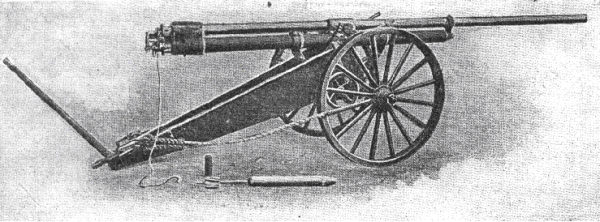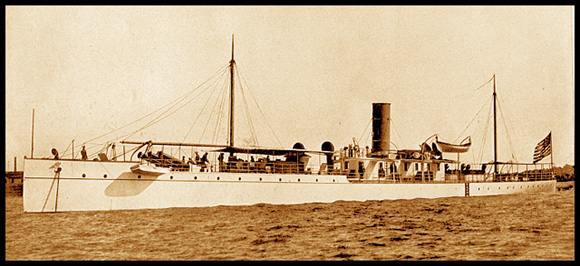Gunpowder has been used so long that alternatives are rarely discussed.
The US Army and Navy considered liquid propellants for large guns
during the 1990s.
Ideally, two liquids would be used which are inert themselves, but highly
explosive when mixed (like Triex and Quadrex). The gunner would turn valves so the
desired amount of liquids
mix
in or near the gun chamber. This would allow the use of very high explosives for greater
range, using a foolproof safety concept. Obviously, the "gunpowder" industry was
not thrilled with this idea and it has been
dropped.
The next leap forward in propellants may be compressed air. The US Army used a
"dynamite gun" (below), really a pneumatic or
compressed-air gun, with an effective range of 900 meters during its 1898 fight in Cuba.

However, modern gun systems could use powerful commercial air
compressors to achieve far greater power. A
powerful diesel compressor could rapidly compress air in the gun chamber.
The US Air Force uses a gas gun to fire projectiles MACH 7 as part of its
scramjet research; see AEDC
Scramjet. Air is
far less hazardous since it is not transported and stored, it is just sucked out
of "thin air." This would cut ammo transport and storage needs in half. Air is also much cheaper than chemical
propellants; its free. Rate of fire is another
advantage since artillery guns can only fire
Modern
engineers would need to determine how the projectile could be
loaded and how long it would take a compressor to generate the necessary
pressure, although jack hammers "fire" rapidly. The range could be
changed simply by adjusting the air pressure. Since range is based on the
ability to compress air and the strength of the barrel, it would be possible to
fire a
Boosting range with rocket propulsion is possible if each projectile had a rear chamber with a small hole. As the air pressurizes in the gun chamber, it automatically pressurizes the air in that chamber. After the projectile leaves the gun barrel, the compressed air in the rear chamber sprays out to reduce drag and propel the round. An even more radical step would be to replace the explosive in the common blast/fragment munitions with compressed air. Extremely inexpensive and safe projectiles would be injected with compressed air just prior to fusing.
The use of pneumatic guns for warships has already been tried. A "dynamite gun cruiser" the USS Vesuvius (below) was commissioned in 1890 with three 15-inch pneumatic guns. These guns were fired during the Spanish American war with mixed results. The quiet guns surprised the enemy, but they were not mounted on turrets, so aiming was difficult. It was a crude design with a maximum range of 2000 meters, which was adjusted by changing the air pressure.

Air cartridges may also be developed for small arms. CO2 cartridges have
been used in powerful air guns for years. Perhaps highly compressed air could
replace gunpowder in cased small arms ammunition. The advantages are
significant, no muzzle flash, and no barrel heating
Carlton Meyer editorG2mil@Gmail.com